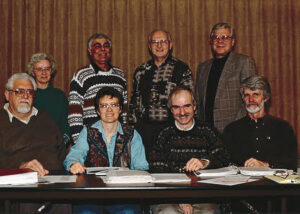In the Future Directions conversations, many people expressed a lingering concern that the proposed regional network forming Mennonite Church Canada could cause us, as a church family, to lose a nationwide sense of shared mission and identity. The fear is that each region will be preoccupied with its own local agenda and, therefore, will pull back from connecting with the broader church.
Several volunteer-led working groups have tabled reports on specific aspects of our national church ministries, and how questions or risks might be addressed in the new structure. All reports are available at mennonitechurch.ca; follow the “2017 Special Assembly” link.
People who have relatives in other Mennonite churches, or have attended more than one Mennonite church in their lives, take for granted the idea of a larger church family. Newcomers, whose experience of the Mennonite church is in their local congregation, are less likely to feel connected to congregations elsewhere. With newcomers to the church being the growing part of our denomination, it is good to examine why a shared identity matters.
To this end, the report from the Working Group on Vision and Identity is a must-read. After re-affirming the well-known Healing and Hope vision statement, the working group walked through the biblical basis for being a church together across theological and geographical diversity, and pointed out the benefits of a nationwide church identity. It outlined the types of actions that nurture identity, examine our current strengths, and discuss the vulnerabilities of the new structure.
Since 2015, when the Future Directions Task Force tabled the report that proposed the regional network model, it was clear to us at Canadian Mennonite that this magazine is a connecting thread across the country. Under the network model, the role of a publication like ours to share what is happening across the churches becomes even more important. We are gratified that the Vision and Identity Working Group, under the proposed structure, believes Canadian Mennonite would be an important vehicle to help keep people in communication with one another.
It also suggested “story sharing,” in which each congregation across the country could contribute at least one story, blog, sermon or worship resource a year, and suggested there be a comprehensive list of podcasts, sermons, or blogs from pastors in our denomination. Both of these suggestions are similar to ideas we have discussed at Canadian Mennonite and would like to build into our website. Stay tuned for details.
Independent of the above, the Communications Working Group reviewed the communication efforts of each area and national church and considered the work that Canadian Mennonite does, before issuing its report: “In light of the Future Directions’ call for greater focus on local congregations within their regions, cross-Canada communication will be more important than ever if the church is not to be completely localized. . . . The denomination needs to tell its story—and its many stories—of how God is working through the church (locally, regionally, nationally and beyond) and through its members. . . . The intent is to keep aiming for the overarching story of us as a Mennonite people in relation to God’s story.” The working group encouraged us, as a whole church with many voices, to tell our stories in print, online and in person, and to ensure that we allocate the financial resources necessary to make this story-sharing possible.
When affirming the continuation of this magazine as a partner in church communications, the Communications Working Group added a challenge: re-think the role and format of this publication. They said to consider “rebranding to create a new thing and [do] some bridge-building in areas where trust has been damaged.”
Canadian Mennonite is a magazine and online presence for, and of, the church. We note the call of the Communications Working Group, and must consider further their suggestions. We are glad, however, to be recognized for having our own role to play in maintaining—even strengthening—a sense of shared identity.







Leave a Reply
You must be logged in to post a comment.